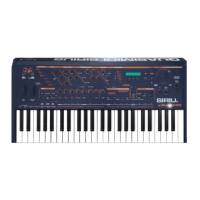Menu-page 6: Gate-time (note-length)
Menu-page 7: Motion
This parameter decides if a note is played with staccato (=0, very short) or legato (=127, connected to
next note). You can change this parameter in 128 steps.
The motion-parameter gives you the replay-direction of the stored notes. You can select from the
following settings:
Edit Arpeggiator
<6> Gate: 64
Edit Arpeggiator
<7> Motion: UP
The Arpeggiator
63
Motion -Replay Direction Function
UP
DOWN
UPDW - up and down
RND - random
ASGN - assign
RVSD - reversed assigned
ASG2 - forward and
reversed assign
MOT1 bis MOT9
Here the notes of the chord will be played from the lowest to the
highest.
Here the notes of the chord will be played from the highest to the
lowest.
Here the played chord will be repeatedly played up and down and
back again
With „random” the notes of the chord will be played by pure
chance, without a special order.
Here the notes of a sequence are played in the order they are
played on the keyboard. With the similar activated „Hold”
Function and by leaving out a key, you can easily put in complete
melodies. You just leave out the first note of the melody and the
following you just shortly tap on.
Basically works the same way as the ASGN. Here the notes are
replayed in reverse order.
Has the same function as ASGN and RVSD. Here the notes will
be played in the order they have been played in and then the
other way around.
With these pattern you got free programmable replay-orders that
also could be polyphonic. The MOT1 to MOT9 are manufactured
pattern. Of course you can change these pattern any time on your
behalf.

